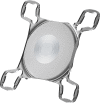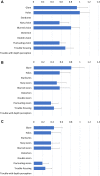Refractive and Visual Outcomes After Implantation of a Secondary Sulcus Intraocular Lens with an Extended Depth of Focus
- PMID: 35711970
- PMCID: PMC9192784
- DOI: 10.2147/OPTH.S366145
Refractive and Visual Outcomes After Implantation of a Secondary Sulcus Intraocular Lens with an Extended Depth of Focus
Abstract
Purpose: To evaluate the range of vision, visual function, and quality of vision after implantation of a secondary extended depth of focus intraocular lens (EDOF IOL) implanted in the sulcus.
Setting: One clinical practice in Haugesund, Norway.
Design: Prospective single arm non-interventional study.
Methods: Eligible subjects presenting for surgery, or who had previous successful primary cataract or refractive lens exchange surgery in both eyes were subsequently implanted with the AddOn® secondary EDOF IOL in the sulcus. Manifest refraction and visual acuity at distance, intermediate and near were measured 3 months after surgery, along with the monocular defocus curve. Subjects also completed a visual function and a quality of vision questionnaire.
Results: The study included 32 eyes of 16 subjects. At 3 months postoperative, the mean refraction spherical equivalent (MRSE) was -0.16 ± 0.30 D, with a residual cylinder of 0.29 ± 0.27 D. The mean monocular uncorrected VA was 0.1 logMAR (20/25) or better at all test distances. The monocular defocus curves showed a depth of focus of 2.0 D. For every category except reading fine print, all but one subject (94%) had no difficulty or little difficulty with near tasks. Glare and halos were the most common visual disturbances, with no reports of starbursts. There was no evidence of any intralenticular opacification in any of the eyes, and no evidence of iris chafing/depigmentation.
Conclusion: This secondary EDOF IOL provided excellent distance and intermediate vision, and very good near vision to subjects. Subject reported near visual function was also very good and visual disturbances were limited. This lens appears to be a good option for patients who would like to improve their range of vision. Results appear as good or better than those reported for primary EDOF lenses.
Keywords: AddOn EDOF; EDOF; extended depth of focus; secondary IOL; sulcus.
© 2022 Gundersen and Potvin.
Conflict of interest statement
Dr. Gundersen is a consultant to Alcon, Staar, Santen, Centricity, and Glaukos. Dr Potvin reports grants from 1stQ Gmbh, during the conduct of the study; personal fees from Alcon, outside the submitted work. The authors report no other conflicts of interest in this work.
Figures




Similar articles
-
Efficacy of a Secondary Trifocal Sulcus IOL in Providing Near and Intermediate Vision in Patients with Prior Myopic Laser Vision Correction and Cataract Surgery.Clin Ophthalmol. 2022 Jul 8;16:2219-2226. doi: 10.2147/OPTH.S372925. eCollection 2022. Clin Ophthalmol. 2022. PMID: 35837490 Free PMC article.
-
Prospective comparative study of tolerance to refractive errors after implantation of extended depth of focus and monofocal intraocular lenses with identical aspheric platform in Korean population.BMC Ophthalmol. 2019 Aug 19;19(1):187. doi: 10.1186/s12886-019-1193-z. BMC Ophthalmol. 2019. PMID: 31426775 Free PMC article.
-
Visual performance of a new Extended Depth of Focus (EDOF) intraocular lens: Preliminary results.J Fr Ophtalmol. 2022 May;45(5):529-536. doi: 10.1016/j.jfo.2021.10.007. Epub 2022 Jan 26. J Fr Ophtalmol. 2022. PMID: 35090757
-
Refractive and Visual Outcomes After Implantation of a Secondary Toric Sulcus Intraocular Lenses.Clin Ophthalmol. 2020 May 18;14:1337-1342. doi: 10.2147/OPTH.S255725. eCollection 2020. Clin Ophthalmol. 2020. PMID: 32546940 Free PMC article.
-
Visual Performance of a New Extended Depth-of-Focus Intraocular Lens Compared to a Distance-Dominant Diffractive Multifocal Intraocular Lens.J Refract Surg. 2018 Apr 1;34(4):228-235. doi: 10.3928/1081597X-20180125-01. J Refract Surg. 2018. PMID: 29634837
References
LinkOut - more resources
Full Text Sources

